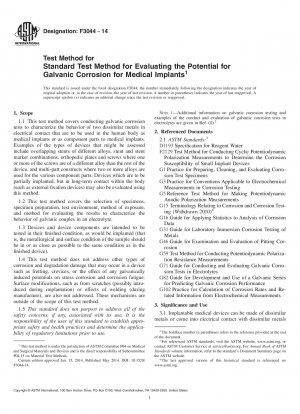ASTM F3044-14
Test Method for Standard Test Method for Evaluating the Potential for Galvanic Corrosion for Medical Implants
- Standard No.
- ASTM F3044-14
- Release Date
- 2014
- Published By
- American Society for Testing and Materials (ASTM)
- Status
- Replace By
- ASTM F3044-20
- Latest
- ASTM F3044-20
- Scope
3.1 Implantable medical devices can be made of dissimilar metals or come into electrical contact with dissimilar metals leading to the potential for galvanic corrosion, which may result in the release of corrosion products with harmful biological consequences or a compromise of structural integrity of the device. Therefore, it is important to determine the susceptibility of these types of devices to galvanic corrosion.
3.2 Use of this test method is intended to provide information on the possible galvanic component of corrosion of two dissimilar metals in contact with one another. The dissimilar metals in contact may be on the same implantable medical device or as component parts of individual medical implant devices.
3.3 This test method has been designed to accommodate a wide variety of device shapes and sizes encountered by allowing the use of a variety of holding devices.
3.4 This standard is presented as a test method for conducting galvanic corrosion tests in a simulated physiological environment. Adherence to this test method should aid in avoiding some of the inherent difficulties in such testing. Other standards such as Guide G71 are general and, while they provide valuable background information, do not provide the necessary details or specificity for testing medical device implants.
1.1 This test method covers conducting galvanic corrosion tests to characterize the behavior of two dissimilar metals in electrical contact that are to be used in the human body as medical implants or as component parts to medical implants. Examples of the types of devices that might be assessed include overlapping stents of different alloys, stent and stent marker combinations, orthopedic plates and screws where one or more of the screws are of a different alloy than the rest of the device, and multi-part constructs where two or more alloys are used for the various component parts. Devices which are to be partially implanted, but in long-term contact within the body (such as external fixation devices) may also be evaluated using this method.
1.2 This test method covers the selection of specimens, specimen preparation, test environment, method of exposure, and method for evaluating the results to characterize the behavior of galvanic couples in an electrolyte.
1.3 Devices and device components are intended to be tested in their finished condition, as would be implanted (that is, the metallurgical and surface condition of the sample should be in or as close as possible to the same condition as in the finished device).
1.4 This test method does not address other types of corrosion and degradation damage that may occur in a device such as fretting, crevices, or the effect of any galvanically induced potentials on stress corrosion and corrosion fatigue. Surface modifications, such as from scratches (possibly introduced during implantation) or effects of welding (during manufacture), are also not addressed. These mechanisms are outside of the scope of this test method.
1.5 This standard does not purport to address all of the safety concerns, if any, associated with its use. It is the responsibility of the user of this standard to establish appropriate safety and health practices and determine the applicability of regulatory limitations prior to use.
Note 1—Additional informati......ASTM F3044-14 Referenced Document
- ASTM D1193 Standard Specification for Reagent Water
- ASTM F2129 Standard Test Method for Conducting Cyclic Potentiodynamic Polarization Measurements to Determine the Corrosion Susceptibility of Small Implant Devices
- ASTM G1 Standard Practice for Preparing, Cleaning, and Evaluating Corrosion Test Specimens
- ASTM G102 Standard Practice for Calculation of Corrosion Rates and Related Information from Electrochemical Measurements
- ASTM G15 Standard Terminology Relating to Corrosion and Corrosion Testing
- ASTM G16 Standard Guide for Applying Statistics to Analysis of Corrosion Data
- ASTM G3 Standard Practice for Conventions Applicable to Electrochemical Measurements in Corrosion Testing
- ASTM G31 Standard Practice for Laboratory Immersion Corrosion Testing of Metals
- ASTM G46 Standard Guide for Examination and Evaluation of Pitting Corrosion
- ASTM G5 Standard Reference Test Method for Making Potentiostatic and Potentiodynamic Anodic Polarization Measurements
- ASTM G59 Standard Test Method for Conducting Potentiodynamic Polarization Resistance Measurements
- ASTM G71 Standard Guide for Conducting and Evaluating Galvanic Corrosion Tests in Electrolytes
- ASTM G82 Standard Guide for Development and Use of a Galvanic Series for Predicting Galvanic Corrosion Performance*, 2024-04-20 Update
ASTM F3044-14 history
- 2020 ASTM F3044-20 Standard Test Method for Evaluating the Potential for Galvanic Corrosion for Medical Implants
- 2014 ASTM F3044-14 Test Method for Standard Test Method for Evaluating the Potential for Galvanic Corrosion for Medical Implants

Copyright ©2024 All Rights Reserved